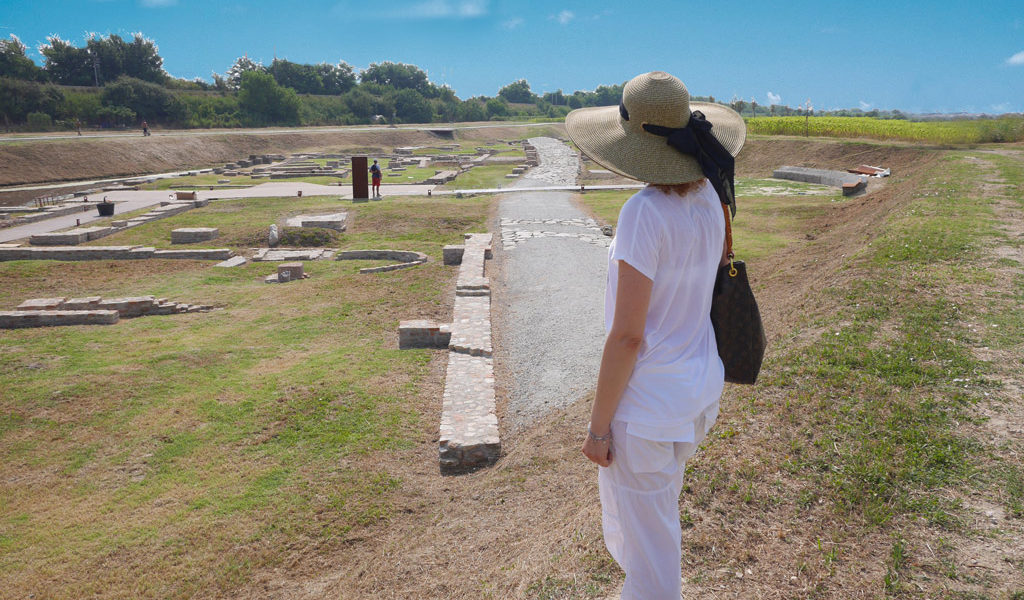
23/03/2018
VISITING THE OUTSKIRTS OF RAVENNA:
SAN MARINO
With its fortress on Mount Titano it is the third smallest country in Europe. It is also considered the oldest republic in the world and the tradition dates its foundation to the year 301 A.D. It’s an easily accessible tourist location which you may define a small treasure trove of natural beauties, monuments, museums, libraries and parks. In the top of the mountain stand the three Fortresses or Towers connected by paths between squares, palaces, museums, churches and still well-preserved stone medieval houses. Most impressive during the summer months are its medieval days and the Grand Prix Moto GP. Just 100 km far.
GRADARA
Its castle dates back to the 12th century. It is interesting to recall the ancient times while you go around the battlements and past the drawbridge to its elegant courtyard. Its interiors are reminiscent of the splendor of the powerful families who ruled here: Malatesta, Sforza and Della Rovere. Here is where the sad story of Paolo and Francesca took place, the poor lovers in Dante’s Divine Comedy in the fifth Canto of the Inferno. 75 km
FORTRESS OF SAN LEO
Previously County of Montefeltro, it housed Dante and Saint Francis of Assisi, in whose prisons the Count of Cagliostro was confined. 100 km
THE PATH OF THE GNOMES
If during a walk in the woods of Arminia, at Bagno di Romagna Terme, you happen to catch a quick movement in the bushes, sharpen your sight! You may notice a red pointed hat … that belongs to one of the many Gnomes inhabiting this forest, so that Bagno di Romagna has been renamed “The Land of the Gnomes” … The path of the Gnomes is an easy path, a little more than 2 km long, nestled in the forest, which also houses wooden houses, animals silhouettes and stone sculptures; in short, a FABULOUS PATH! This trail, equipped and safe, is perfect for children as well, but it must be followed with respect for nature, and if you really wish to see or hear a gnome, you must forget your doubts and just be carried away by imagination.
THE AZZURRINA GHOST
Montebello’s ghost: in a castle located in the province of Rimini, in the second half of the sixteenth century, a little girl mysteriously disappeared. She was Guendalina Malatesta who lived during the Middle Ages, but is known by all as the Azzurrina ghost. The little girl was an albino, which in the Middle Ages was a symbol of suspicion and fear. Therefore, she was accused of witchcraft and doomed to an atrocious death. Her parents, who were worried about her terrible fate, decided to color her hair with a herbal potion which darkened it, but caused it to emit bluish reflexes upon exposure to sunlight. That is why all began calling her Azzurrina (Bluish). The story tells us that her strange death occurred on June 21, 1375: Azzurrina, playing inside the castle with a rag ball and strings, suddenly disappeared as vanished into nothingness. From June 21, every five years, on the night of the summer solstice, the Azzurrina ghost appears in the castle of Montebello and you may listen to her laughs or weeping and even hear her voice. Today, the castle is visited by thousands of people not only for its historical and artistic value, but for the Azzurina ghost as well.
BERTINORO
It is still a typical medieval town, once a very ancient settlement, since the iron age. In this charming hamlet you may taste the famous sweet wine “Albana”, hence the name of the town. History tells us that the great poet Dante Alighieri, upon a visit to the small village, while tasting Albana’s nectar produced by local vineyards, said:”Non di così rozzo calice sei degno, o vino, ma di berti in oro” [You’re not worthy of so rough a goblet, oh wine, but to be drunk in gold] hence the name Bertinoro… km30
BRISIGHELLA
It is a delightful village, famous for its medieval urban layout, a maze of cobbled lanes, dominated by the particular Via degli Asini, raised and porched, an ancient defensive bastion protecting the hamlet. Everything here speaks of a distant ancient world. It is famous during summer for its original medieval festivals. Km 30
CASTROCARO
Inside its fortress, myths and legends hand over stories of love and death. Famous is the legend of young Margherita, who was given in marriage by her parents to her cousin Guidone, although she was in love with another young man. With great pain, she chose the tall tower of the castle and, during a windy, moonless night, she threw herself into the void. Still today, it is said that in certain moonless nights, you may hear her cry of love which the wind disperses in the valley. It is also famous for its thermal baths, its medieval festivities with “In Taberna” dinners, ludic-historic-culinary dinners in medieval tavern, its falconry exhibitions and typical restaurants. Km 35.
PREDAPPIO
The history of Predappio dates back to Roman times, when Augustus divided Italy into 11 provinces. Predappio was part of the sixth province. Its name probably derives from an ancient family, the “Appi”, which the resort was named after: Praesidium Domini Appi, Pre Di. Appi. Here are the ruins of a castle, an ancient church and the remains of a Roman villa of the first century A.D. Archaeological findings have also attested the presence of human settlements since the Bronze Age and Roman era. The town of Predappio gave birth to two historical figures: Benito Mussolini, head of fascist dictatorship, and Adone Zoli. In the cemetery of the nearby San Cassiano are the tombs of both families.
SALINE DI CERVIA
“Cervia’s White Gold”, whose birth dates back to Roman times. Salario (salary) derives from sale (salt), which was part of the remuneration received by Roman soldiers. They are considered an environment of high naturalistic and landscape interest. Since 1979, they have become National Natural Reserve of animal population: a kingdom of about 70 species of birds, including pink flamingos, black-winged stilts and avocettes that enjoy the small microorganisms in the silt of its waters. Also interesting is the museum area with the “Salt Warehouses” and the annexed saline activity museum. Km 20
CERVIA AND THE MARRIAGE OF THE SEA
Even today, we do not know if it is legend or reality. It is said, however, that in the year 1445, Pietro Barbo, Bishop of Cervia, was caught in a terrible gale and that, in order to quench the sea storm, he pledged his pastoral ring to the waters, thus saving both himself and the crew. The Bishop then promised that every year, on Ascension Day, he would celebrate this event with a solemn ceremony. Every year, indeed, the event is repeated, where the Bishop blesses both the Adriatic sea and the boats sailing it, takes the wedding ring, where the words “Cervia, marriage of the Sea, Year ..” are engraved. And after pronouncing the words of blessing, he throws the ring tied to a ribbon, where a group of young men waits to readily resume it. For those who retrieve the ring, it is a symbol of good luck and prosperity, keeping it as a souvenir or as a wedding ring should they get married.
COMACCHIO
With the presence of canals, ancient palaces and monumental bridges, it is known as “Little Venice.” Possible original trips by traditional boats (batane) through the canals of the historic center. In the epic poem “Orlando Furioso”, Ludovico Ariosto wrote: “è la città ch’in mezzo alle piscose paludi del Po teme ambe le foci, dove abitan le genti disiose che l’mar si turbi e sieno i venti atroci” [it is the city which, in the midst of the pondic swamps of the Po, fears both outlets, where people live, eager that the sea is turbid and there are atrocious winds]. Km 40
CESENATICO
A lovely town with a small harbor designed by Leonardo Da Vinci, in the historic center, where during the Christmas season you can admire the beautiful crèche on the fishing boats anchored at the pier. Km 30.
MILANO MARITTIMA
This is the VIP seaside resort with elegant shops and restaurants. Km 20
Info: Tel: 0544.456665 – Mail: info@hotelmosaico.it
